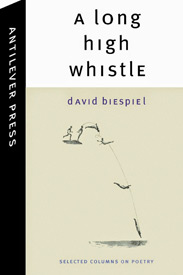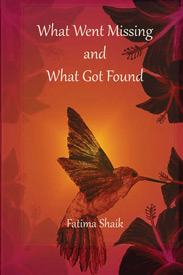Fiction and Poetry
A Long High Whistle: Selected Columns on Poetry
David Biespiel (CAS’86)
Antilever Press, 2015
 For people reluctant to do the intellectual heavy lifting they believe poetry demands, the only thing more inaccessible than the form itself is what’s written about poetry. But both the novice and the aficionado will delight in Biespiel’s A Long High Whistle. As engaging as they are enlightening, these short essays come from the acclaimed poet’s (Charming Gardeners, The Book of Men and Women) popular monthly column for the Oregonian.
For people reluctant to do the intellectual heavy lifting they believe poetry demands, the only thing more inaccessible than the form itself is what’s written about poetry. But both the novice and the aficionado will delight in Biespiel’s A Long High Whistle. As engaging as they are enlightening, these short essays come from the acclaimed poet’s (Charming Gardeners, The Book of Men and Women) popular monthly column for the Oregonian.
Among the 100 or so poets Biespiel considers are John Keats, Emily Dickinson, Pablo Neruda, and Seamus Heaney. None longer than four pages, the essays range all over the literary landscape, from Ovid to Alexander Pope to Elizabeth Bishop, from ancient China to contemporary Greece. Read as a whole, the collection is akin to a poetry course taught by a witty, passionate professor who is the very definition of well versed.
In “To See the Invisible,” drawing largely from Donald Justice’s lovely, spare “Memory of a Porch: Miami, 1942,” Biespiel writes about poets’ attentiveness to “invisible geographies,” to “see what exists, into what exists, nearly what exists, and beyond what exists.” His amusing essay “Continuous Music” hits a common chord with its discussion of the haughty dismissal (“It happens more than I care to admit”) of poems that rhyme. “The worst offenders,” he writes, “are aspiring poets.”
Biespiel’s warmth and respect for his readers is reflected in prose that, like William Zinsser’s classic On Writing Well, makes us care about, and be alert to, the wonders of metaphor, simile, and inspired restraint. Biespiel reminds us that every poem poses three questions: “First, can a poet measure meaning? Second, can that measurement influence thought? And finally, if a poet can measure meaning,” can a poet, as Herbert strives to do in his poem reflecting, as Biespiel puts it, “one man’s resilient humanity” against authoritarianism’s dogma, “describe even the ‘simplest emotion’ from the intimate to the political in the service of humanity?”
The question may not have a simple answer. But as in all of Biespiel’s charming meditations, it whets the appetite for poetry of all kinds, and reminds us that poetry matters.—Susan Seligson
Quality Snacks
Andy Mozina (GRS’90)
Wayne State University Press, 2014
 Mozina’s latest collection delivers what its title promises: an array of palatable stories, each with a distinct, satisfying flavor. He spins 15 fabulistic tales, most set in and around Milwaukee and Chicago (it doesn’t get more delightfully Midwestern than this story opening: “Two grown men at the Dairy Queen…”).
Mozina’s latest collection delivers what its title promises: an array of palatable stories, each with a distinct, satisfying flavor. He spins 15 fabulistic tales, most set in and around Milwaukee and Chicago (it doesn’t get more delightfully Midwestern than this story opening: “Two grown men at the Dairy Queen…”).
Mozina is at home with this form, combining both variety—the smorgasbord of stories ranges from a man’s account of his “nonsexual affair” to a tale that has Santa Claus playing Major League Baseball—and cohesion in the collection. Many of these stories involve impossibly broken relationships. The best of the collection feature narcissistic male protagonists.
Take “A Talented Individual.” Mozina’s wry prose shines in this tale of a condescending businessman approaching middle age who has been passed over for a promotion. He’s driven to reassess his life and while he mopes around during a vacation with his wife and children, he ruminates on how everything that once seemed bright and shiny is no longer: his MBA from Northwestern hasn’t snagged him a higher-paying position, and to his dismay, his “smart and physically fit” wife has parlayed her attributes into becoming more successful than he ever imagined. It’s clear from the start that he’s edging closer and closer to a full-blown existential crisis. In fact, most of Mozina’s characters experience some form of personal crisis—even Santa Claus questions his very being.
Throughout many of his narratives, Mozina deftly injects the underlying emotions of his characters—like fear, dissatisfaction, and pain—into depictions of food, which can be more revelatory than the characters themselves.
The best reflection of Mozina’s use of food as metaphor is in the title story. Here, a divorced “senior project scientist” at the North American Frito-Lay headquarters has fallen in love with one of the company’s VPs and sets off to pursue her. It doesn’t bode well that the same man whose job is to manufacture artificial satisfaction—tinkering with MSG and maltodextrin to get the perfect taco, guacamole, or salsa flavorings on chips—says, “Quality snacks and quality relationships are not opposed but complementary.”
The protagonist is so tied to his work that he gorges on Doritos back at his bachelor pad (Mozina displays some Jonathan Franzen-level corporate mockery as the man purchases at a local gas station the very chips he works to create). The chips are a prelude to the nausea-inducing combo of cherry soda and spaghetti doused in “sauce spiked with dangerous amounts of Lawry’s” he consumes before bingeing on porn for the rest of the night. Mozina humorously explores addiction in this quirky tale—addiction to sex, to work, to food—and the instant gratification mentality so prevalent in society today. Fitting, since his collection is gratifying and may leave readers hungry for more.—Mara Sassoon
What Went Missing and What Got Found
Fatima Shaik (COM’74)
Xavier Review Press, 2015
 It’s pretty much a given that New York is the most interesting city in the United States. But what would be in second place?
It’s pretty much a given that New York is the most interesting city in the United States. But what would be in second place?
You can make a strong argument that city would be New Orleans, founded by the French, expanded by the Spanish, French again under Napoleon, and then sold to the United States. As such, its residents never spent a day under British rule (Andrew Jackson saw to that), or under finger-wagging, old-line Calvinism.
New Orleans is a city replete with contradictions not easily explained, a Deep South town that was awash in slavery, but where races mixed easily, a sultry Gulf port that shipped goods barged down the Mississippi River from the Canadian border.
The Crescent City is famed for its music (African), its cuisine (Gallic), and its architecture (Hispanic). There is no place remotely like it in the rest of America, particularly in its defining quality: as an endlessly impoverished place that nonetheless doggedly celebrates everyday life.
That’s the city portrayed in Shaik’s new short story collection.
It is usually summertime in her underbelly city, blast furnace hot, a season devoid of festivals, conventions, and tour buses. This city is populated by poor blacks and Creoles who couldn’t afford to leave town even if they wanted to (and after many generations in the bayous, they don’t want to). They work blue-collar jobs, when they can find them. Their air-conditioning is open windows, shady trees, or fishing trips. Their entertainment is stoop-sitting, family picnics, and endless conversations.
The characters in these 14 stories are a motley assortment of damaged souls, among them an aged trumpeter, a mute daughter, a polio survivor, a self-styled parson. They may sound like a sad lot, but Shaik treats them tenderly and makes sure they’re more than that. Her characters, oddballs in a city replete with them, usually have friends and relatives to tend them. Poor in the usual ways, these residents of the Ninth and Seventh Wards have vibrant social lives that many a lonely Manhattanite might envy.
Shaik’s strengths as a writer are in creating everyday dialogue, in painting her characters’ lives, in moving her plotlines quietly and slowly along. She brews her characters—their status, their intellect, even their skin color—slowly, like tea steeping in a porcelain pot. A few of her stories have abrupt endings, but this New Orleans native and St. Peter’s University professor sure can turn a phrase.
In the story “Life Is for the Living,” she reflects how “true integration could be demonstrated by the Creoles showing the unity of all races and human appetites when holding the French bread, Spanish onions, Italian salami, German mustard, Creole tomatoes, and Louisiana hot sauce.” It’s a line that deftly serves up the city’s cuisine, culture, and racial reality. One of the strongest stories is “Achille’s Jass,” about a talented horn player whose career fizzled in an instant long ago: “‘Can’t you shut your trap,’ he was famously quoted in the newspaper when he shouted at a patron in The Blue Room. Musicians all over town called to thank him. But none would take him up on the bandstand anymore.” The story chronicles a last performance at a friend’s second-line funeral.
Another top-notch tale, “Maurice in the City,” tracks a New Orleans exile hiding among New York’s throngs after being suspected in the killing of his girlfriend. The author captures the dynamics of both cities beautifully, switching between them with ease, sometimes pausing gently to compare. In New York, she reflects, “most streets were numbered, not named, like in New Orleans, for dreams, saints and myths.”
The last few stories have plotlines wedded to the calamitous flooding caused by Hurricane Katrina, and this book is being published on its 10th anniversary. By matter-of-factly relaying the unfolding horrors that challenge her characters as the water relentlessly rises, Shaik personalizes and deepens the tragedy in a way that a litany of statistics would not. In compelling fiction such as this, there is power, and truth.—Jim Concannon













































 For people reluctant to do the intellectual heavy lifting they believe poetry demands, the only thing more inaccessible than the form itself is what’s written about poetry. But both the novice and the aficionado will delight in Biespiel’s A Long High Whistle. As engaging as they are enlightening, these short essays come from the acclaimed poet’s (Charming Gardeners, The Book of Men and Women) popular monthly column for the Oregonian.
For people reluctant to do the intellectual heavy lifting they believe poetry demands, the only thing more inaccessible than the form itself is what’s written about poetry. But both the novice and the aficionado will delight in Biespiel’s A Long High Whistle. As engaging as they are enlightening, these short essays come from the acclaimed poet’s (Charming Gardeners, The Book of Men and Women) popular monthly column for the Oregonian.
 It’s pretty much a given that New York is the most interesting city in the United States. But what would be in second place?
It’s pretty much a given that New York is the most interesting city in the United States. But what would be in second place?
Related Stories
Former Poet Laureate Pinsky Designs Anthology for Aspiring Poets
CAS prof’s book offers “ways to learn from the poetry of the past”
Five Famous Alums: Writers
Pulitzer winners and best sellers
Pinsky Teaches Poetry…to the World
New BU MOOC offers rigorous, lively look at creative process
Post Your Comment